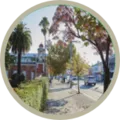Research Cluster 2: Improving Urban In- and Outdoor Climate (Head: Werner Lang)

Due to the high density of buildings, the related thermal storage capacities, reduced air movement, intensity of heat sources such as buildings and cars, high degree of sealed surfaces, and lack of green areas, cities are hotter than the countryside. Because of the urban heat effect, climate change has a particularly strong impact on dense settlement structures, especially during the night, when high air and radiation temperatures have a negative influence on health and the quality of sleep of the urban population.
RC2 aims at the improvement of the urban in- and outdoor climate by
- (i) assessing the causes and magnitude of the before-mentioned negative effects on human comfort and health; and
- (ii) developing solutions to overcome these challenges by employing the main RTG strategies.
UGI as a substitution strategy can help to regulate the (micro)climate by providing shade, acting as windbreaks, and cooling public areas and the immediate surroundings of buildings through evapotranspiration. Furthermore, plants absorb CO2 and store carbon, while O2 is released into the atmosphere. Green unsealed areas and the soil with the deposition of pollutants can serve as a source of nutrients to UGI, as well as a water reservoir during heavy rain. To fully understand the effects of outdoor UGI on indoor heating and cooling, and occupant’s thermal comfort, the underlying dynamics of plants and vegetation, the response patterns to different climatic and growth conditions, and the combined (dis)services of different tree species close collaboration of colleagues within Cluster 2 (SP6 - Energy, SP7 - Microclimate, SP8 - Urban Trees, SP9 - Health) and with Cluster 1 (SP3 - Reconstruction, SP5 - Design) and Cluster 3 (SP10 - Drainage, SP12 - Microbiome) is required. Cluster 2 explores the potential of the integration of UGI in inner cities to improve in- and outdoor comfort and to reduce energy consumption and the related carbon footprints in a changing climate and thereby also substitute technical systems. Mapping, modeling and prediction of UGI, including trees, hedges, lawns, roof and facade greening, will be an essential basis for the projects similar to that of Cluster 1 (SP3 - Reconstruction, SP5 - Design) and Cluster 3 (SP10 - Drainage, SP12 - Microbiome), as they all build on UGI, and aim at their structural and functional improvement. Another important aspect to address in RC2 is the operationalization of the relevant measures (substitution, integration) by analyzing the performance of the suggested strategies and the options for integration and implementation of the relevant measures into the transformation and design process. It is necessary to bridge the gap between theoretical analysis and the implementation of the developed methods in the context of complex urban planning processes. To achieve this, close collaboration within RC2 and with RC1 (SP1 - Biodiversity, SP2 - Mobility, SP4 - Governance) is required.
The subprojects of research cluster 2 are

SP6: Indoor Comfort and Energy Consumption of Buildings
PI: Prof. Dr.-Ing. Werner Lang
Doctoral Candidates: Roland Reitberger & Farzan Banihashemi

SP7: Microclimate-Green Infrastructure Interactions
PI: Prof. Dr.-Ing. Stephan Pauleit
Doctoral Candidate: Nayanesh Pattnaik

SP8: Structure, Functioning and Ecosystem Services of Urban Trees
PI: Prof. Dr. Dr. Hans Pretzsch
Doctoral Candidate: Leila Parhizgar

SP9: Spatio-temporal Patterns of Pollen and Fungal Spores and its Impact on Health and Disease
PI: Prof. Dr. Claudia Traidl-Hoffmann (Universität Augsburg)
Doctoral Candidate: Open